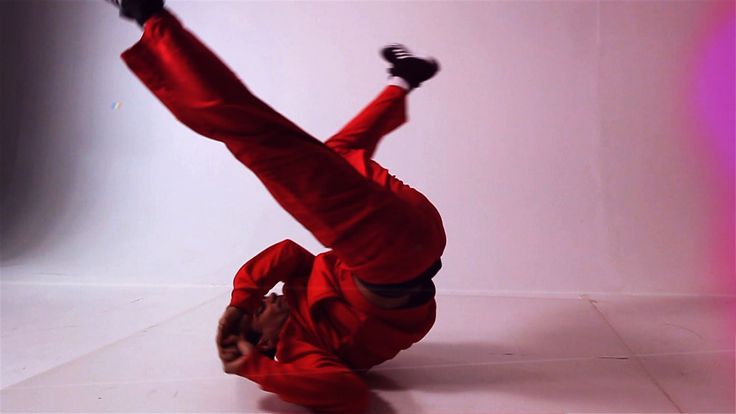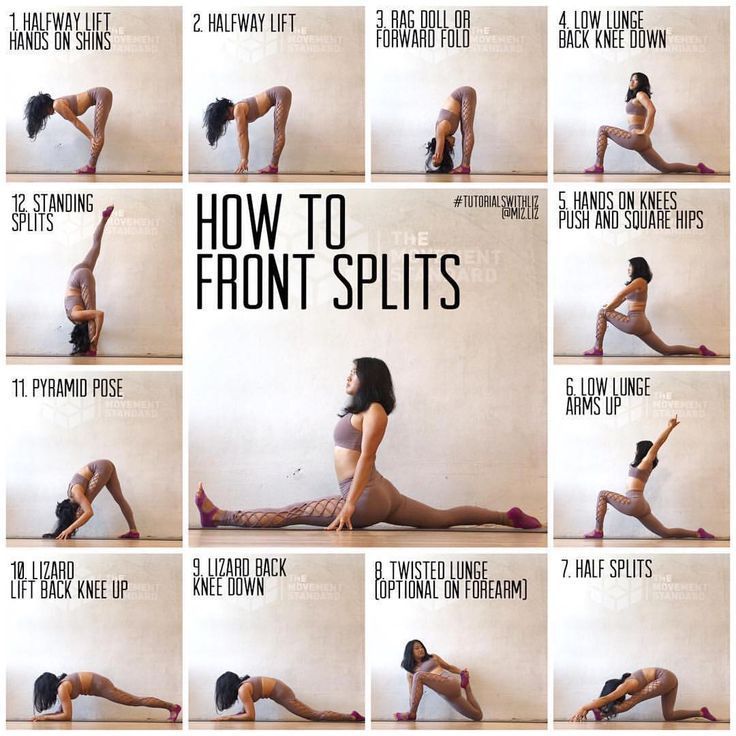How to stretch your knees for dance
Do These Stretches To Dance Better (And Stay Injury-Free!)
We all know that stretching is important for you to dance better.
That's why we sought professional advice from Karen Moran, owner, founder, and clinical director of FusionArts Physical Therapy in Encino, CA. to help you stretch the right way.
Here’s what you need to stretch to dance better and stay injury-free!
When to stretchThis may sound hard to believe, but there is such a thing as over stretching.
Most dancers use stretching as the only way to get ready to dance; however, stretching without any kind of warm-up could set you up for injury.
"It’s important to warm up before class or before a performance; do something cardiovascular to warm your body up and to increase your heart rate.”
– Moran
Moran’s clients range from dance students to professional performers, and neglecting to stretch after dancing is one of the most common mistakes her clients make.
“Most dancers or performers just run out of the theatre after their performance is over. They remove their makeup, take off their costumes and off they go. It’s so important to take 5 or 10 minutes after a show to stretch before going home and, if they can’t, then once they get home.”
And consistency is key – incorporate stretching as well as these 5 Simple Daily Practices To Improve Your Dancing
What to stretchThough dancing is a full-body workout, some muscles are used more than others and therefore, need more attention after.
Stretching your feet and legs seems like a no-brainer, but there are other muscles at work that aren’t as obvious.
Your hip flexors, for example, allow you to lift your knees and bend your waist.
They also play a key role in keeping your hips and lower back strong, flexible, and aligned. Your quadriceps move your knees and help rotate your hips.
They are involved and engaged in almost all leg movements.
The piriformis muscle is located behind your gluteus maximus and assists with rotating your hips and turning out your feet.
Stretch these often-neglected parts of your body in order to dance better and stay injury-free!
How to stretch
Hip Flexor/Quad
Kneel in a deep lunge with your back leg on the floor. Flatten your back until you feel the stretch in the front of your hip.
Make sure you tuck your pelvis in to ensure your back is flat; sinking into your back too much is too much extension.
Hold for 20 to 30 seconds and repeat on the opposite side.
Stand holding onto a chair with your right hand and grasping your left foot with your left hand.
Maintain a flat back and pull your heel toward your butt, keeping your knee close to your opposite leg.
Make sure you tuck your pelvis and be careful not to hike your hip up. Hold for 30 seconds and repeat on the opposite side.
Calves/Heels/Feet
Stand with your right foot behind you and left foot in front. Keep your heels on the floor and your feet parallel. Bend your front leg while keeping your back leg straight.
Put both hands on a wall and lean forward, keeping your arms straight, until you feel the stretch in your calf. Hold for 30 seconds and repeat on the opposite side.
Start in the previous stretch position and bend both knees. Lean into the wall until you feel the stretch in your lower thigh. Make sure you keep your back straight.
Hold for 30 seconds and repeat on the opposite side.
Piriformis
Lay on your back with your knees bent and place your right ankle on the opposite knee.
Grasp your unelevated thigh behind the knee and pull gently toward your chest until you feel the stretch in your butt.
Hold without bouncing for 30 seconds and repeat on the opposite side.
Hips
Sit upright on top of a foam roller (Moran recommends using OPTP brand) and cross your right leg over the left knee as shown.
Place your hand beside you on the roller, feeling the stretch in your hip.
Make sure your knee isn’t too high and you’re sitting directly on your sit bones (the bones directly under your butt). Hold for 30 seconds and repeat on the opposite side.
Knee Flexion
Lay on your back with a towel roll under your lower back. Place a resistance band under your left foot and use it to raise your left leg.
Keep the opposite knee bent with your foot flat on the floor. You should feel the stretch in the back of the thigh. Hold for 30 seconds and repeat on the opposite side.
Repeat two times.
Listen to your body! If you feel pain doing any of these stretches, then stop immediately.
Don’t be afraid to seek professional help from a physical therapist if you have recurring pain.
If you keep your body happy and make sure to give it some TLC, then it will return the favor and help you keep dancing for as long as possible.
Special thanks to Telley Maybir (GRV, Boxcuttahz), Ervin Buenaobra (Director of Cerritos Dance and Drill and IQ, Prototypes, Fam Biz), and Quest Studios.
Liked those stretching tips? You might enjoy this video, too!
We hope this guide helped give more examples of helpful stretches you can do to dance better and keep the injuries far, far away. Share this article with your dancer friend that could use the tips!
Dance Stretches for Straight Knees
Stretches for Sore Legs
Good Ways to Warm Up Your Knees
by Mikel Chavers
- Share on Facebook
Hannah Bettes, the 16-year-old dancer and 2012 cover model finalist for “Dance Spirit” magazine, looks like she’s genetically predisposed for ballet. Her hyperextended knees mean her legs curve slightly beyond a straight position, illustrating the hyperextended leg line the ballet world prizes, according to the “Herald-Tribune” newspaper. But not all dancers are born with the hyperextension genes. There’s an opposite condition where the knees look bent even when fully straightened. Sometimes referred to as hypoextension or underextension, underlying causes can include tight muscles in the backs of the legs. Safe hamstring stretching techniques can help straighten the knees, according to “Pointe Magazine.” Lacking hyperextension may seem like the opposite of good dance DNA. But there’s a trade-off. Dancers without hyperextension and tighter muscles actually have more longevity, “Pointe Magazine” reports.
There’s an opposite condition where the knees look bent even when fully straightened. Sometimes referred to as hypoextension or underextension, underlying causes can include tight muscles in the backs of the legs. Safe hamstring stretching techniques can help straighten the knees, according to “Pointe Magazine.” Lacking hyperextension may seem like the opposite of good dance DNA. But there’s a trade-off. Dancers without hyperextension and tighter muscles actually have more longevity, “Pointe Magazine” reports.
Stretches with Exercise Bands
Elastic exercise bands can help dancers stretch the backs of the legs and knees. Performed seated on the floor with both legs stretched in front of you, exercise bands are wrapped around the bottom of one foot. Grasping the ends of the exercise band in each hand, stretch the backs of knees by flexing the foot against the resistance of the band. Pull the exercise band against the flexed foot for the stretch. For another stretch, alternate flexing and pointing the foot against the exercise band. Never force the stretch or perform this stretch with cold muscles, according to “DanceTeacher” Magazine.
Never force the stretch or perform this stretch with cold muscles, according to “DanceTeacher” Magazine.
Stretches at the Barre
Classic ballet stretches at the ballet barre also target the backs of the legs. Stand facing a ballet barre. You can also use a low counter or windowsill as a support if you don’t have a barre. Lift one leg to the front and place it on the barre. Keeping the leg straight to work up to a stretch is the best way to stretch safely, according to “Pointe Magazine.” Raising a straight leg engages the quad muscle and stretches the hamstring -- a winning combination for straighter knees. Once the leg is resting on the barre, flex the foot and gently bend the supporting leg to stretch. Bend the supporting leg and pivot a quarter-turn away from the leg until your raised leg is perfectly to the side of your body. Your body will be perpendicular to the barre. Flex the foot and bend the supporting leg to stretch the leg to the side.
Modified Hamstring Stretch
Stretching in splits or straddle positions target the backs of the legs, of course, but modified hamstring stretches can stretch the muscles without overstretching.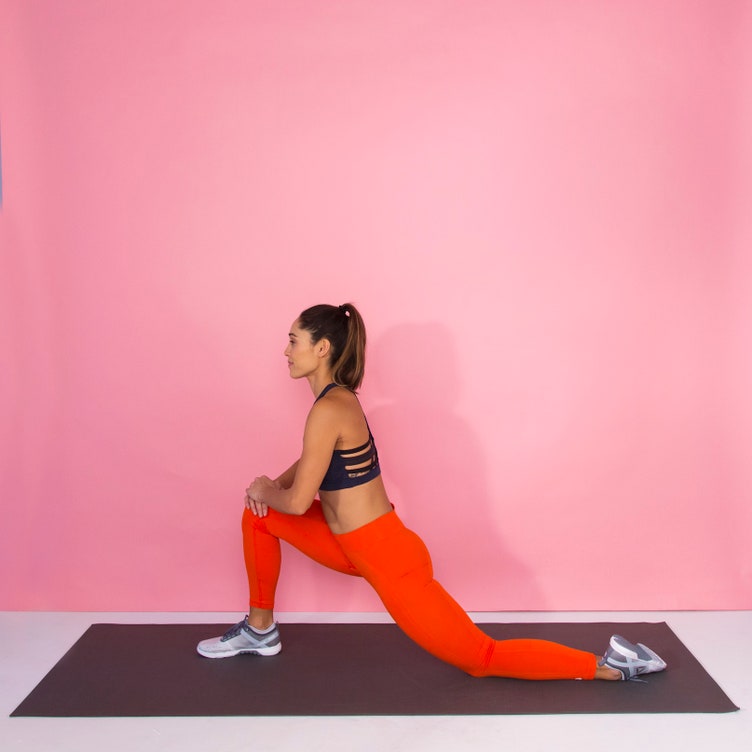 Kneel on the floor. Slowly stretch one leg straight in front of you. Flex the foot and rest the heel on the ground. To complete the stretch, rest your fingertips on the floor on either side of your body and bend slightly forward. Focus on bringing your chest toward your knee while keeping your back straight. Repeat with the other leg extended to the front.
Kneel on the floor. Slowly stretch one leg straight in front of you. Flex the foot and rest the heel on the ground. To complete the stretch, rest your fingertips on the floor on either side of your body and bend slightly forward. Focus on bringing your chest toward your knee while keeping your back straight. Repeat with the other leg extended to the front.
Considerations
To avoid injury, it’s important to recognize the dangers of overstretching or forcing a stretch, says “DanceTeacher” magazine. Pain during stretching means you’re probably overstretching, the magazine reports. Overstretching can lead not only to weaker muscles, but also to muscle tears and even a pulled hamstring. Always warm up muscles before stretching, and don’t be afraid to modify a stretch. If the barre is too high to stretch without feeling major pain, use a lower support such as a windowsill or the back of a chair.
References
- DanceTeacher: Mindful Moderation
Writer Bio
Mikel Chavers has been writing and editing since 2006, specializing in health, business, government and technology topics. She got her start as a reporter at “The Business Journal” in Greensboro, N.C., and later covered state government for a national magazine. Chavers holds a Bachelor of Arts in media studies/journalism.
She got her start as a reporter at “The Business Journal” in Greensboro, N.C., and later covered state government for a national magazine. Chavers holds a Bachelor of Arts in media studies/journalism.
Image Credit
Nick Laham/Getty Images Entertainment/Getty Images
SHARE SHARE TWEET EMAIL
More Articles
4 exercises that can kill your knees
July 13, 2020
Iya Zorina
Author of Lifehacker, athlete, Candidate Master of Sports
Share
0A person with healthy knees is not afraid of almost any exercise, be it squats with heavy weights or jumps. The problem is that few people can boast of perfect health of the knee joints.
Flat feet, overweight, muscle imbalances, past injuries, and a sedentary lifestyle can all take a toll on knee health and, together with overuse, cause pain and inflammation. Here are four exercises that can cause knee pain and how to make them safer.
1. Leg extension on the machine
This exercise works well on the rectus femoris muscle - one of the heads of the quadriceps, but it can hurt the knees. The fact is that during the extension of the legs, the tense quadriceps shifts the lower leg, and the anterior cruciate ligament, which counteracts the shear force, experiences more stress.
In this case, the muscles on the back of the thigh that interfere with the shear force are not involved in the work, so that the entire load falls on the ligaments. In the long run, this can lead to damage to them and pain in the knees.
How to reduce your risk
If you only want to train your quads, replace the chair leg extension with less stress on your knees. Attach an ankle weight and extend the knee within a limited range of 45° to 90° (full extension).
If you just want to pump your hips, replace the extension with multi-joint exercises: squats, leg presses in the simulator, lunges.
2.
 Hurdler Stretch
Hurdler Stretch This exercise is used to stretch the muscles on the back of the thigh. During it, one leg is straightened in front of the body, the thigh of the second is taken to the side, and the knee is bent.
This position of the second leg is not only uncomfortable, but also dangerous for the joint. In a book on exercise physiology, Tommy Boone explains that this movement stretches the tendon of the knee and can cause the patella to shift as well as damage the medial meniscus.
As a result, stretching causes pain in the knee and can cause knee instability, which increases the risk of injury.
How to reduce risk
Just don't take your other leg back - leave it in front of your body.
Photo: Alexander StarostinThis way you protect the knee and stretch the back of the thigh just as well.
3. Narrow stance squat
Photo: Julia Obolenskaya Shoulder stance squats are used to focus on the quadriceps, the muscle on the front of the thigh. In fact, the only thing that pumps better in such squats is the calf muscles. The quadriceps, on the other hand, tense up no more than in squats with medium and wide legs.
In fact, the only thing that pumps better in such squats is the calf muscles. The quadriceps, on the other hand, tense up no more than in squats with medium and wide legs.
Narrow stance squatting increases the shear force in the knee joint, which increases stress on the ligaments and can lead to damage.
How to Reduce Your Risk
Squat with your feet wider than shoulder width to reduce the shear force on your knees. Also, watch your squat technique: keep your heels on the floor and try not to turn your knees inward during the lift.
Photo: Alexander StarostinAnd don't work with weight until you can squat with proper form. So you will surely protect yourself from knee pain.
Learn how to squat properly 🧐
- How to do barbell squats to get results, not problems
4. High jumps and long jumps
which muscles produce maximum force in minimum time. They develop explosive leg strength, increase speed and agility, but at the same time put a lot of stress on the knee joints.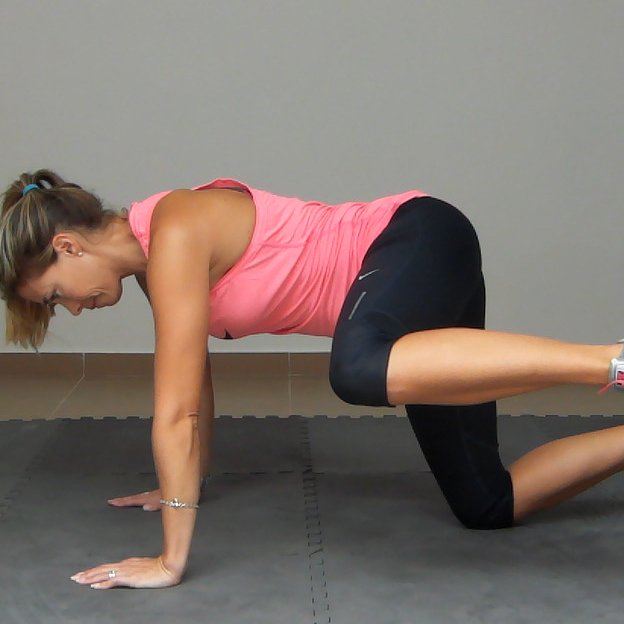
Daniel Baumstark, physical therapist and owner of a sports medicine clinic in Washington DC, says that plyometric exercises significantly increase the risk of orthopedic injury compared to other types of training: during landing, the knee joints experience a load of 2.4-4, 6 times body weight.
Orthopedic surgeon and researcher Frank R. Noye says repetitive stress from jumping exercises can cause jumper's knee, an inflammation of the tendon that connects the kneecap to the tibia.
This condition causes pain and stiffness in the lower part of the kneecap. At first, pain may only occur during flexion and extension of the knee, such as squatting. But gradually it intensifies and prevents not only playing sports, but also just walking, climbing stairs or sitting in a car.
How to reduce the risk
To perform jumping movements without harming your knees, you need to have strong leg muscles and abs, do not overdo it with the load, and perform movements with good technique.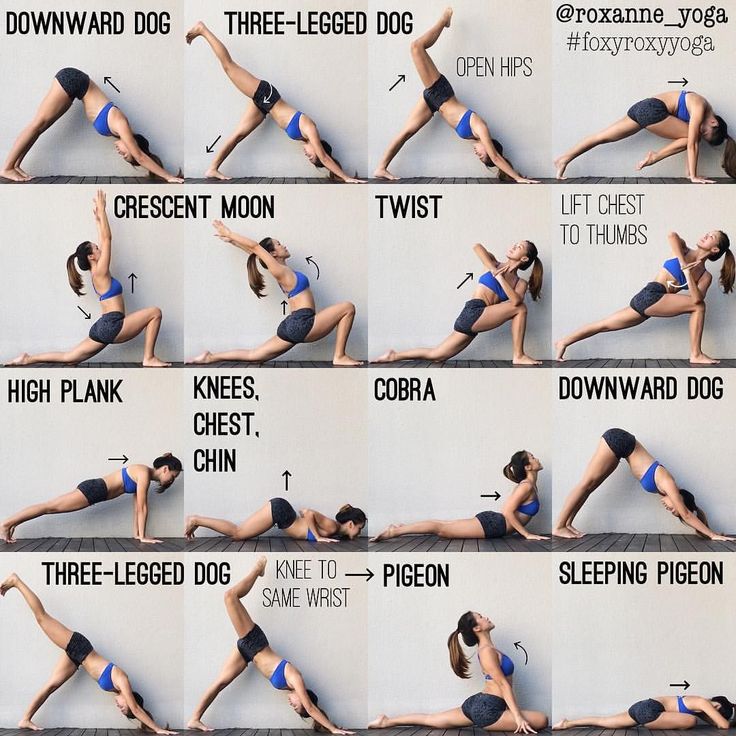
It is important to land with the hips in the correct position - they should not curl inwards. You can check for this error in squats: if you can't keep your knees in place during the lift and they curl inward, it's too early for you to move on to explosive movements.
Also don't jump if you're new to the sport, overweight, or have old knee injuries. Except when you jump under the supervision of a coach who will correctly select the load and be able to notice flaws in technique in time.
If health and fitness is your goal, not weightlifting, sprinting, or team sports, strengthen your hips and glutes with other, safer movements.
Share in the comments after which exercises your knees hurt.
Read also 🧐
- 11 ways to make strength training less dangerous for your joints
- How to start running: a complete guide for beginners
- 22 common beginner gym mistakes
- 5 bodyweight exercises that can harm you
Swing, concepts of arms, steps, HIP-HOP mechanics (practice)
In this topic, it is important to disassemble - the power of the swing - the types of the swing (by direction, by accent, by state) - the swing in certain parts of the body - the swing in positions and planes
- swing for musical elements
Power of swing.
Everything is simple here. We train with the guys different variations of the swing in terms of strength: weak, normal, strong.
First, we work in each of the options. We pay special attention to a strong and clear swing, because. this option is more complex and requires some control of the body. But also such a swing is a powerful freestyle component and adds energy to the whole dance.
Then we combine different types of swing in freestyle, change the strength depending on the track or musical moment.
Types of rock.
In this subtopic, we analyze all possible swing variations, moving away from the basic one (with an accent down)
In the direction of the swing, it can be:
-forward -backward -sideways -obliquely -up -circular
-down -up -impact (blow) -impulse (emphasis on the initial jerk) -double -torn
Status. In this case, we take different states and modify the quality relative to it. For example, a swing in a "curtain" or "water" state will be softer than a swing in a "rock" or "ball" state.
For example, a swing in a "curtain" or "water" state will be softer than a swing in a "rock" or "ball" state.
To consolidate the material covered, you can complete the task: Freestyle exclusively on the quality, changing its strength, accents, state.
Next, you can go a little “deep” into the body and develop in more detail the sensation of swinging in each part of the body.
It is worth noting that in each part of the body all the above-mentioned swing variations work (strength, directions, accents, states)
In this format, the work is built according to the scheme already known to us:
We take one part of the body and try to apply to it all the knowledge of the swing that we already have. We select parts of the body: head, shoulders (one at a time and together), chest, body, pelvis, knees).
Quality in different parts of the body.
After the dancer has more or less figured out the swing, felt it and became able to modify it, it's time to learn how to hold the swing in difficult dance positions.
This stage is very important for the dance to be a hip-hop freestyle, and not just a flow of movements. In this case, it is very important to develop a feeling of swing in absolutely any difficult position.
How do we build the training process? Very simple and creative.
We came up with a position, gave it to the students, they picked it up and begin to swing in it, using the knowledge that they had already received earlier.
They stood, shook, came up with a new position, changed, shook again. The logic, I think, is clear.
Next, you can go to the ground and analyze the concepts and positions that took place earlier and apply the same quality to them.
Having figured out a little how to swing in different difficult positions, you can fix the theme with freestyle. The task of the guys is to move between positions, but not to lose a constant quality.
Quality and music.
At the last stage, when the student's body is already “uploaded”, you can move on to the relationship between rocking and music.







